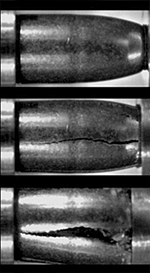Frangible
Another (simpler) way of thinking of it is, "if it shatters, it's frangible; if it squashes, it's not." Frangible objects can also be described as brittle.
Frangible bullets
A frangible bullet is one that is designed to disintegrate into tiny particles upon impact to minimize their penetration for reasons of range safety, to limit environmental impact, or to limit the danger behind the intended target. Examples are the Glaser Safety Slug and the breaching round. The Winchester Black Talon round was also somewhat (though by no means completely) frangible, after a fashion.
Frangible bullets will shatter/disintegrate upon contact with a surface harder than the bullet itself. Frangible bullets are often used by shooters engaging in close quarter combat training to avoid ricochets; targets are placed on steel backing plates that serve to completely fragment the bullet. Frangible bullets are typically made of non-toxic metals, and are frequently used on "green" ranges and outdoor ranges where lead abatement is a concern.[1][2]
Frangible structural components
A frangible light pole base is designed to break away when a vehicle strikes it. This lessens the risk of injury to occupants of the vehicle. Frangible supports are also used for Airport Approach Structures.[3]
References
- ↑ Tony L. Jones, FRANGIBLE AND NONTOXIC AMMUNITION, Police and Security News
- ↑ Frangible Ammunition, GlobalSecurity.org
- ↑ Wright Aldridge, "A Lesson in Safety", Federal Highway Administration

This article about ammunition is just a stub, and should be expanded
